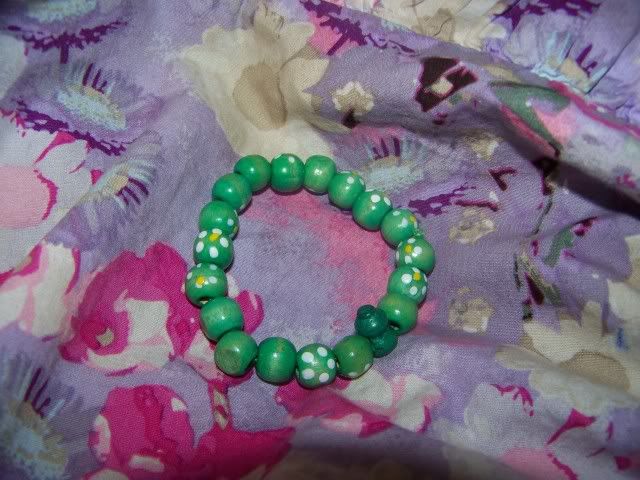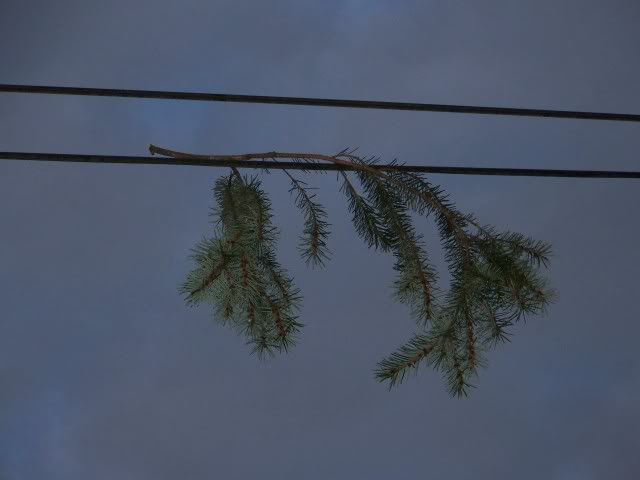Kyrie
Anna
Kyrie's first picture was literally just grass. I was pleased when she instead decided to try shots of this bracelet, which she conveniently got as a present from the neighbor today (Thanks, Sara!). And she took a whole bunch of shots against various backgrounds and with various other "props" involved. She took many of the shots about 2 inches from the bracelet, so I'm kind of impressed that any of them focused; usually the camera has extreme trouble that close-up.
Hmm, let's see. I learned a ton from reading my cousin's post today about re-learning her new camera (and the comments and the links in the comments). So much so that... my shot today was shot in manual! Yay me!
SS: f3.6
Ap: 1/800
(My camera doesn't store the iso, but it was probably 200)
The most useful thing that I learned from those links (that I didn't already know) was that my camera has a light meter, and that I can use it to help pick shutter and aperture settings. I already had some idea of under what conditions I might want a low or high shutter speed, or a low or high aperture. But I couldn't figure out what to do with the remaining settings once I had the one I wanted. One of the links explained that you should generally try to aim your light meter to 0.0, plus-or-minus some depending on personal preference. Once I found the light meter (it was one of the few things left I hadn't figured out in manual mode, and it ranges from about -4.0 to +4.0), I could really start figuring out my settings much better.
The links also had some useful recommendations for a starting place with the iso's. Basically 100 for outdoor daylight and 800 for indoors (maybe 200-400 if it's especially well-lit, which my place is decidedly not). I used 200 for most of the shots I took outside today because it was completely overcast.
Despite all that I learned, I still had to use the flash to get the branch to be green. No amount of raising the iso could get as good of a shot. Instead, it just turned the sky bright white. Changing the other settings didn't help. The basic problem was that the sky was a lot brighter than the branch, so the only way to make it not look dark against a light background was to shine more light on it, through the flash. (Although now I am suddenly remembering one of the "scene" mode settings is for "backlit" things, and I wish I had thought to try that; it's too dark now.) The best shot that I got without the flash showed an almost-white-but-still-slightly-blue sky with a very-dark-but-you-can-just-barely-tell-it's-green branch. And that shot just couldn't match the green and the moody sky in this one.
Through my own experimentation, I learned that the fourth setting in my camera's manual mode - the one that isn't shutter speed, aperture, or iso... is for how bright the flash is.
Let's see, what else did I learn. I learned that when I point the camera at the row of Douglas-firs behind our apartments, the lowest possible aperture setting (the widest open) is f2.8, but when I point the camera at the branch in the picture (with lots and lots of sky behind it), the 2.8 setting disappears and the lowest f-stop I can hit is f3.6. I have no idea why this is. Frankly, it seems a little bit insane for the camera to suddenly decide it won't let me change the aperture lower even if I want to. But there you go. Maybe it's trying to protect itself from being damaged by too much light? Maybe if I had changed the iso lower and the shutter speed faster, it would have allowed the 2.8 again? Is it even possible for a camera to be damaged by too much light? I'm thinking not on a cloudy, overcast day, at the very least. It's not even like I was pointing it at the sun or something.... that comes later in the challenge. :/
Well, that was a lot of learning about cameras for one day. What I'd still like to learn more about is how to take good ultra close-up photos, and I think I'll need some practice with the long-exposures and night shots.



Yeah they were helpful weren't they? I was like... Oh... yeah... I need an order of operations to set these silly settings! Perfect!
ReplyDeleteAlso, I saw your comment at work and had no idea. I planned to look on my camera when I got home but by the time Toby went to bed and I had time, you figured it out. :) So that is good.
I think you'll need a bigger lens for ultra close up. At least I never had success with it except with SLRs.
Also: I am pretty sure there is no way to ruin a camera with too much light. I mean, you can ruin a picture, but a camera's job is just to reflect light around onto a surface that can turn it into a picture (ex: used to be film, now its whatever program digitally interprets light). I have no idea why your camera is doing that, but I suspect it's just not letting you because of some programming error designed to keep you from taking bad pictures or something that has gone awry.
Nice green pictures!! (If I ever do this, I am sooo taking a picture of Percy the Train). I mean unless it's warm out enough that there is actual greenery outside, which this side of the state is sorely lacking right now.
-Lisa
I'm not buying a bigger lens yet. I will probably get one in the long haul, but for now it's both not affordable and I still need to get more practice in at making the most out of the camera/lens that I've got. I figure that with close-ups, my lens will have some limitations, but I want to see just how far I can push it.
ReplyDeleteAs for the aperture change... today it seemed like it was changing every time I turned the flash on or off... but I don't remember changing the flash around when I was switching around in manual mode yesterday between the trees and the hanging branch.